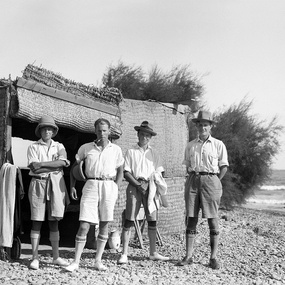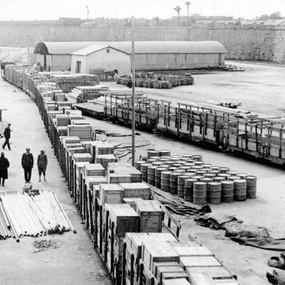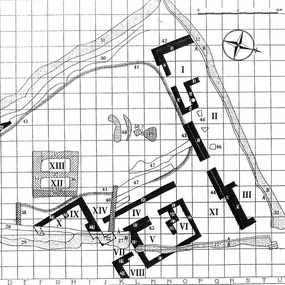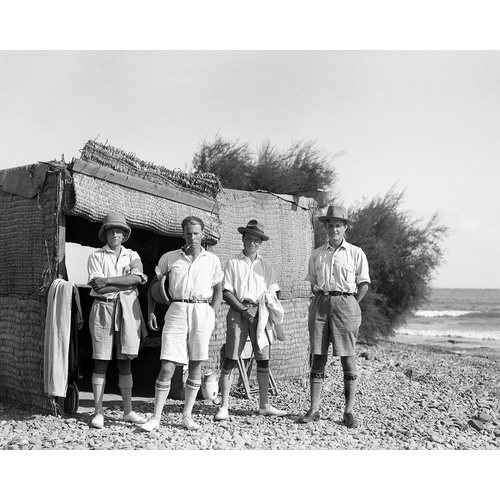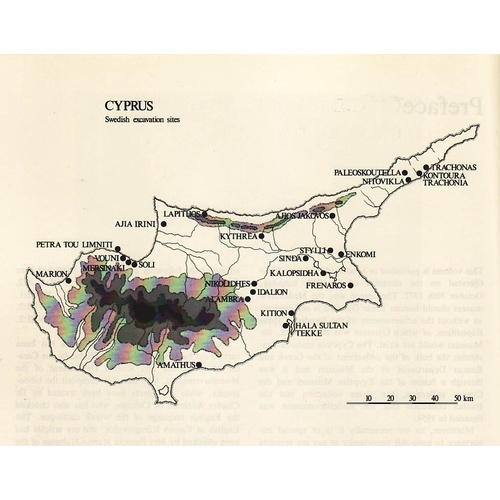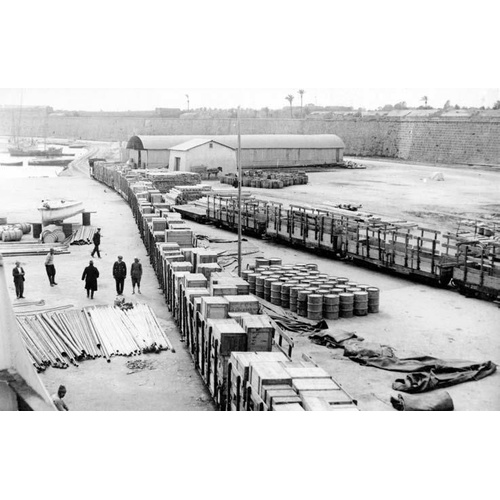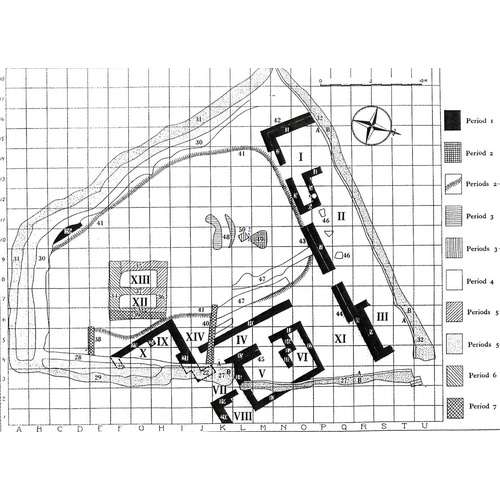Major archaeological discoveries are the result of both good fortune and painstaking work. The archaeology of Cyprus is one of the most distinct cases of such a combination. The monumental work accomplished between 1927 and 1931 by the Swedish Cyprus Expedition was the outcome of the work of four young Swedes who worked under the leadership of Einar Gjerstad. Settlements, tombs, sanctuaries, palaces and theatres from 25 sites all over the island, ranging in time from the Neolithic to the Roman period, were investigated, producing some 18,000 properly excavated objects. This was an unprecedented corpus of archaeological material that even today “constitutes the cornerstone” of archaeological research on Cyprus [Fig. 1].
This contribution had a dual goal: to present a brief overview of the circumstances under which Cypriote archaeology was initiated,1 and to discuss some of the complexities of the publication of the sanctuary of Ayia Irini. The latter is arguably one of the most reputed discoveries of the Swedish Expedition in Cyprus and the subject of an ongoing research project at Medelhavsmuseet in Stockholm.2
The Swedish Cyprus Expedition
As is frequently the case with big archaeological ventures, the initial impetus of the Swedish Expedition in Cyprus was rather coincidental. It was Einar Gjerstad himself who published some of the "behind the scenes" details in his book Ages and Days in Cyprus.3 In March 1922, on his way to Greece to conduct excavations at Asine, Axel Persson, Professor of Classical Archaeology at the University of Uppsala, encountered Lukas Pierides, Swedish consul in Cyprus and a collector of antiquities. Pierides asked Professor Persson to lend him 10 pounds for a transit visa through Bulgaria, reassuring him that he would receive his money back upon his arrival in Athens, a request to which professor Persson responded positively. This incident took place on an Orient Express train in Serbia and was repaid by an invitation to Cyprus for archaeological research and a pricey present of Cypriote Antiquities to the Swedish Crown Prince. Persson persuaded one of his most competent students, then 25-year-old Einar Gjerstad, who was excavating with him at Asine, to accept Pierides’ invitation.
Gjerstad was unaware of the challenges related to the investigation of Cyprus. Yet he had what was required to undertake the task: a good knowledge of the prehistoric archaeology of the Near East, a trained eye that was familiar with scientific excavation methods and stratigraphic sequences, excellent managing skills, and a Nordic sense of moderation that helped him to create order out of massive archaeological data. During his first visit in Cyprus (1923-1924), Gjerstad undertook several excavations and studied in the museums of the island. That initial study period convinced him that a Swedish expedition in Cyprus could make a meaningful archaeological contribution. The four-year expedition was launched in 1927, funded by many private donors. It received prestigious political support from the Crown Prince Gustav Adolf, an archaeologist himself.
The original concept of the expedition was to undertake excavations in Cyprus with the goal to establish a chronology for Cypriote archaeology.4 The members of the Expedition had to investigate different types of contexts, in different parts of the island. Cyprus was a suitable field for archaeological action of this sort. Not only had it not yet undergone a systematic archaeological exploration but also, being an island, its geographic boundaries were firmly fixed, making it possible to obtain an overview of its ancient remains by means of some years of systematic excavations.
The expedition departed for Cyprus in the autumn of 1927. It comprised of three archaeologists and one architect: Einar Gjerstad (later professor of Classical Archaeology at the University of Lund), Erik Sjöqvist (later professor of Classical Archaeology at Princeton), Alfred Westholm (later director of the Gothenburg Art Gallery) and the architect John Lindros. Within the four years that the Expedition was active in Cyprus (until 1931), numerous major sites were excavated and published: Enkomi, Kythrea, Ayios Iacovos, Idalion, Kition, Marion, Amathous, Lapethos, Ayia Irini, Vouni, Soloi, to name a few [Fig. 2].
Approximately two thirds of this outstanding archaeological production was transferred to Sweden in 1931. It constitutes the bulk of the Cypriote collections at Medelhavsmuseet in Stockholm, founded in 1954.
Given the amount of finds, their division between Sweden and Cyprus was an intricate task. After extensive deliberations and the good will of both parts, the division was decided on the principle that tomb groups and find deposits should not be split up but should remain as entire archaeological contexts either in Cyprus or in Sweden. The Swedish Cyprus Expedition would receive a representative series of finds of all periods and of all kinds of objects, although unique objects were to remain in Cyprus. In practice these regulations were subject to diverse interpretations that resulted in remarkable exceptions to the principles of the division. The division of the terracotta statues and figurines from Ayia Irini, although they belonged to the same deposit, is perhaps the most evident case of such modifications. Sweden acquired two thirds of the Expedition’s finds, circa 12,000 of the 18,000 objects, packed in 771 wooden crates that were transported by train from Nicosia to Famagusta and then shipped over to Sweden [Fig. 3]. Sweden also received all the sherd material of any scientific value, a decision that enriched its collections by 5,000 carton boxes containing hundreds of thousands of diagnostic pottery fragments.5
Ayia Irini: Setting the stage for a new research project
The most impressive discovery of the Swedish Cyprus Expedition was unearthed close to the northwestern tip of the island, at Ayia Irini. The site is situated on the rock plateau which extends between the alluvial plain of Morphou and the off-shoots of the Kyrenia range projecting into cape Kormakitis. This area appears as a more or less neutral zone between different city-kingdoms, explaining why Ayia Irini has been associated with both the territory of Lapethos6 as well as with that of Soloi.7 Today, the excavated area, west of the village’s church, lies within a military zone at the occupied part of the island and is inaccessible for archaeological research. The rural sanctuary of Ayia Irini is renowned for its unique corpus of terracotta figures and figurines, an exceptional discovery that has become the centre of attention in a number of archaeological studies.8 It was published in 1935, in the second volume of the SCE series.9 The publication displayed two main accomplishments: the discussion of the site’s stratigraphy, and the stylistic development of almost 2,000 terracotta statues and figurines (not including fragments). Since the archaic terracottas from Ayia Irini provided the basis for the chronological succession of styles in the Archaic Cypriote sculpture, these two goals were closely related. Noticeably, both the stratigraphic and typological conclusions of the Swedish publication have been questioned in recent studies,10 mostly due to the problematic stratigraphy of the site. Groups of finds other than terracotta figures and figurines received less attention in the final publication. Pottery constituted a small fraction of the finds presented and was used primarily for reasons of chronological clarifications. The discussion of pottery only encompassed wholly preserved vessels, a rarity in a sanctuary, and only briefly did it tackle pottery sherds.
The identity of the deity worshipped at Ayia Irini remains unknown.11 In the absence of epigraphic records, discussion of cult at Ayia Irini is based on the votive offerings, especially the terracotta figures and figurines. Most of them portray armed male figures and bulls, hence emphasizing a masculine repertoire. Preference for male divine types is shared by many extra-urban sanctuaries in Cyprus.12 However, female representations are not entirely missing and there is also a marked preference for dual-sexed imagery.13 These elements indicate that a fertility deity, possibly of male character, was most probably venerated at Ayia Irini. Furthermore, evidence suggests a rural yet composite cultic practice that included sacred banquets and dances.14
The importance of the site, the need to clarify aspects of its history, and the site’s inaccessibility for legitimate archaeological research, are the main reasons why Ayia Irini has been the core of a research project at Medelhavsmueet, Stockholm, since 2011. One of the main goals of the project is to deal with vast amounts of unpublished pottery and to use them as a tool to clarify issues of the site’s history and periodization. The quantity of the material (over 100,000 potsherds) indicates a careful and selective approach in order to be able to reach some conclusions.
Ayia Irini: Layers, structures and chronological sequences
The excavation of Ayia Irini started in November 1929, after a priest had brought to Nicosia the head and upper part of an early 6th century BC terracotta statue found on his farm. The farm turned out to be an intact cultic area. It comprised of a large, roughly triangular temenos with a row of built structures mainly along its north and eastern sides [Fig. 4]. Erik Sjöqvist was chosen to investigate the site. However, because of its importance, Ayia Irini was not published by its excavator but by the leader of the Swedish Expedition, Einar Gjerstad. This oxymoron is reflected on the somewhat laborious discussion on the site’s stratigraphy. The latter is characterized by a sequence of severe floods and layers of alluvial sand that often result in stratigraphically impure horizons.
The stratigraphy of Ayia Irini
The stratigraphy of Ayia Irini is documented in a series of 18 drawn sections running through different parts of the excavated area.15 Overall 12 different strata were identified (not all of them were traceable in the whole of the excavated area). These layers were associated with 7 cultural periods ranging in time from the Late Cypriote III, circa 1200 BC, to the 1st century BC. The sanctuary went through a long idle period between the early 5th and the 1st century BC. Aspects of this chronological periodization are in need of further investigation, whereas the presumed unbroken continuity from the Late Cypriote right into the Iron Age has been challenged.16 The most prolific period of Ayia Irini dates to the Late Cypro-Geometric and to the Early Cypro-Archaic periods, coinciding with the time of the consolidation of the Cypriote city-kingdoms.17
Leaving aside stratum 1 that represents the top soil, strata 2, 4, 6 and 8 were associated with the alluvium of floods that affected the site on different occasions: stratum 2 after the end of period 7 causing the site’s final abandonment in the late 1st century BC; stratum 4 between periods 6 and 7 (510-500 BC), stratum 6 between periods 5 and 6 (circa 540 BC), stratum 8 between periods 4 and 5 (600-560 BC). Although Gjerstad tried to establish a system of absolute dates for all strata, he also acknowledged that the flood layers were often intermixed with the upper and lower parts of their preceding and succeeding strata hence the stratigraphy was often disturbed.
What becomes evident in the publication is that floods were a key element to the understanding of Ayia Irini and that they were used to explain stratigraphic discrepancies. Here lies one of the first difficulties related to the study of Ayia Irini: Gjerstad’s wish to establish a sound system of stratigraphic sequences at a site that he had not excavated and where, judging by the publication, stratigraphy was not trustworthy.
Except for the alluvium layers, the rest of the strata display a steadier connection to the different periods of the site and were the ones primarily examined in association with its architectural remains. Periods 1-6 correspond to a more or less continuous use from the 12th to the late 6th centuries BC, whereas period 7, a poor revival in the 1st century BC follows after a hiatus of almost 400 years. Since stratigraphic complexity, in combination with poorly preserved structures and diverse groups of finds form an intimidating bulk of evidence that hampers the first stages of familiarisation with the site, it is interesting to briefly discuss the architectural development of the sanctuary.
Architectural elements
There is restricted architectural visibility of period 2 (stratum 11) that corresponds to the beginning of the Cypro-Geometric period [Fig. 4]. Stratum 11 is represented by a very thin cultural layer that includes a roughly built Temenos wall (wall 41) and the first altar, 49, built of rubble in two or three courses. This marks a sudden change from preceding period I (Late Cypriote III) that was characterized by a building complex erected around a large open court. The Cult House properly occupies a central position on the east side of the complex and is flanked by a rectangular storehouse to the north, part of another building to the west, and a house for cult requisites to the south. With the transition to period 2, the older sanctuary was covered with a thick layer of red earth.
Although no layer or deposit of period 2 contained only Cypro-Geometric I pottery types, Gjerstad argued that there was no long intermediate period between the end of Period 1 and the beginning of period 2. Unluckily, the finds of period 2 are few and the culture stratum is rather thin, suggesting a poor and small-scale cult between Cypro-Geometric I and III periods. This dearth of evidence, combined with the absence of a purely early Cypro-Geometric stratum, raises more questions about the unbroken continuity in the sanctuary from the Late Bronze Age into the Early Iron Age.
Small and larger changes in the outline of the sanctuary also occurred in subsequent phases. The temenos of period 3 (800-650 BC) was heightened and a new altar was erected (altar 50). The transition to period 4 (650-600 BC) inaugurated the peak of Ayia Irini. The same altar (50) was used yet the temenos was enlarged reaching a size of about 40 x 30 metres. The area was enclosed by a new peribolos built of rubble and the floor was raised again. Minor structures were also erected, like the so-called "sacred tree enclosure", while bases and substructures for wooden poles supporting the roofs of two shelters also belong to this period. Starting and ending with a flood, periods 5 (600-540 BC) and 6 (540-510/500 BC) were characterized by raised floors but no major changes occured in the layout of the sanctuary. The same altar was still in use although a lime-concrete slab was placed around its top in period 6. A severe flood at the end of this period covered the whole temenos with a thick alluvial layer and resulted in the abandonment of the sanctuary.
Position of the terracotta statues and figurines
In his extensive discussion on the condition of finds,18 Gjerstad often mentions figurine fragments found intrusively in find spots of different strata and layers that were disturbed and mixed up (this is often the case with finds from periods 3-6). When it comes to non-sculptural objects of the same periods that were not the centre of his attention, their exact position and stratigraphic attribution is vaguely stated: “The non-sculptural objects of Periods 4-6 were found in small groups here and there within the temenos, mainly along the west and north temenos walls”.19
The majority of the terracottas, however, were found in a semicircular arrangement around the altar that was erected in period 3. The smallest statuettes were placed closer to the altar. Gjerstad suggested that their position had been affected by the water streams flooding the temenos, since some had fallen down or were slightly removed from their original position, although their close grouping formed a barrier that reduced the effect of the floods. He also claimed that since successive alluvial layers of periods 5-6 were not removed, the sculptures of those periods were placed on the successively raised levels, gradually creating an almost ideal stratigraphic sequence. According to this scheme, small figurines standing on the floor of the Cypro-Archaic I temenos were entirely covered by the alluvium, whereas larger sculptures were covered almost entirely or up to the chest, depending on their height. This image of half-buried figures projecting from the ground makes it an awkward interpretation. What seems more likely is that figures and figurines belong to a single deposition that must have taken place in the Cypro-Archaic period.
Pottery at Ayia Irini: old publication and current research
Pottery constitutes an important part of the finds from Ayia Irini, but it only played a minor role in the publication of the sanctuary.20 There are only a few images of wholly-preserved vases published,21 the majority of which relate to periods 4 and 5 (650-540 BC). A fraction of the potsherds was also considered in the discussion of the absolute chronology22 although none of the fragmentary material was discussed in detail or illustrated.
Bronze Age vases mainly occurred in the Cult House. Base-ring and Plain White are the chief classes represented in the publication.
Period 2 is only represented by a Black Slip III jug, although the potsherds also included White Painted I and II products. Period 2 yielded considerable amounts of Cypro-Geometric III sherds (White Painted, Red Slip, Black-on-Red and Bichrome wares). Period 3 is mostly characterized by Cypro-Geometric III and Cypro-Archaic I sherds. Periods 4 and 5 are characterized by Cypro-Archaic I and an increasing numbers of Cypro-Archaic II types. White Painted, Bichrome, Black-on-Red, Bichrome Red and Red Slip are all represented. Cypro-Archaic II pottery also predominates in period 6. As far as shapes are concerned, both open and closed vessels attested: jugs and juglets, amphorae and hydriae, plates, goblets with stem, deep and shallow bowls, suggest a composite pattern of food and drink consumption at the sanctuary.
The ongoing study of pottery from Ayia Irini at Medelhavsmuseet tends to amend some of Gjerstad’s conclusions. Information accompanying the pottery fragments was not always complete. Depth and layer were rarely documented although the square number was normally mentioned. Complex stratigraphy, lack of information and missing excavation diaries raise additional obstacles to the study of the ceramics from Ayia Irini. In spite of these difficulties, pottery can still contribute to the discussion about chronology, history and cult, especially since the vast majority of pottery sherds had never been properly examined. Furthermore, the comprehensive study of the Late Bronze Age pottery facilitates comparisons between the sanctuary and the corresponding burials at Ayia Irini. It is also expected to illuminate the earliest, less-known phases of the sanctuary.
The Late Bronze Age phase of the sanctuary has yielded a sparse yet clear attestation in the ceramics record. These sherds form a small fraction of the total amount of pottery examined so far. The majority of the Late Bronze Age ceramics were collected from the rooms of the Cult House, mainly in rooms V and VI, whereas smaller amounts were found in the Bronze Age stratum underneath the "Statue Layer". In spite of the patchy record, ceramics encompassing almost the whole of the Late Cypriote period are attested.
In his publication, Gjerstad had only documented Base Ring and Plain White (wheel-made and hand-made) pottery from period 1: a Base Ring jug, a Plain White wheel-made stemmed goblet and a few fragments of Plain White pithoi. Other Late Cypriote wares are also represented albeit in very small numbers.
Examination of the sherds so far shows that Base Ring I and White Slip II form the predominant Late Bronze Age types at Ayia Irini. Late Bronze Age Bichrome wheel-made is also relatively popular, whereas Plain White and White Painted23 wheel-made types are also attested. Mycenaean imports form a small yet distinctive group and they mostly consist of 3-handle jar fragments with banded or festooned decoration. To these, a few locally-produced imitations of Mycenaean wares can be added.24 The picture emerging from the Late Bronze Age material from the sanctuary allows comparisons with the finds from the tombs of Ayia Irini Paleokastro, the beginning of which is set at the outset of Late Cypriote I, 1650-1450 BC. Paleokastro produced numerous Late Cypriote pottery types, including White Painted V and VI and Proto-Base Ring. However, White Slip and Base Ring wares predominate.
Comparisons are also possible with Toumba tou Skourou,25 just a few km south of Ayia Irini. The site was founded at the transition from the Middle Cypriote III to the Late Cypriote I periods (around 1650/1600 BC). Its most prolific period dates to the late 13th century, although it remained in use until about 700 BC. Next to the indigenous wares (Black Slip, Proto-Base Ring, Base Ring, White Painted, White Slip), the site also produced Aegean imports, mostly Late Minoan IA – IIIB but also Late Helladic III A-B types. The circulation of Late Bronze Age Aegean imports in the northwestern part of Cyprus is now corroborated by the fragmentary material from Ayia Irini.
Although there is no sound evidence for dating cult at Ayia Irini prior to 12th century BC, earlier material is also attested. A small sherd from the bottom layer of square D2 may provide a hint for an occasional activity at Ayia Irini already towards the end of the Middle Cypriote III period (1650/1600 BC), as is indicated by a few fragments of shallow Red-on-Black bowls with a marked rim. Red-on-Black pottery is not frequent in the northwestern part of Cyprus so its occurrence at Ayia Irini is important. These early occurrences can now be matched to the body fragment of a Syrian Middle Bronze Age II (?) jug found amidst Early Iron Age material underneath the statue layer of square L9.
However, the overwhelming majority of the fragmentary material (over 90%) belongs to Cypro-Geometric and Cypro-Archaic types. All major wares are represented, ranging in time from the Cypro-Geometric to the Cypro-Classical periods, although Cypro-Geometric III to Cypro-Archaic II types (850-475 BC) predominate. The large amount of bowls and plates in this material indicates that food and drink consumption was an important part of the cult at Ayia Irini. Closed shapes, mostly jugs, jars and amphorae are also represented. Hellenistic pottery types are extremely rare, as in the case of a plain unguentarium. The quantitative and stylistic analysis of this material will offer valuable information about the sanctuary’s use and development. The study of the pottery is corroborated by that of figurine fragments and the site’s composite stratigraphy. The results of the project will be presented in a comprehensive publication.
